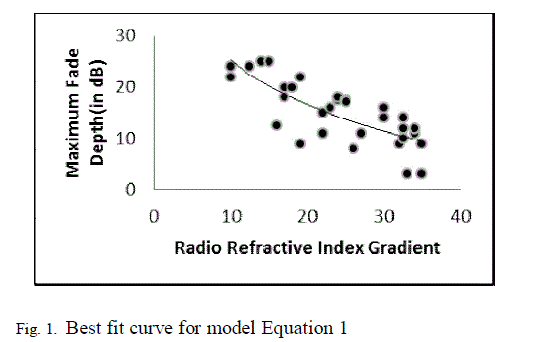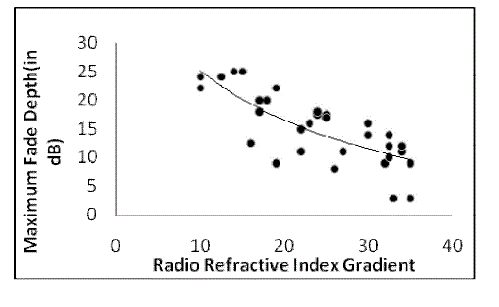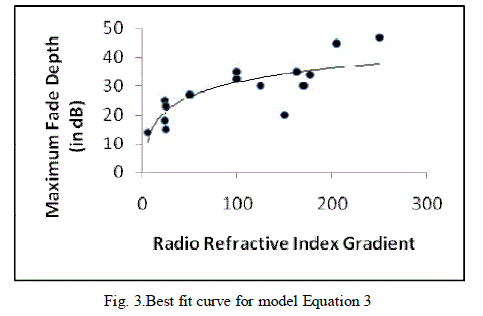ISSN ONLINE(2278-8875) PRINT (2320-3765)
ISSN ONLINE(2278-8875) PRINT (2320-3765)
S.Duttagupta1 and T.R.Ghosh2
|
| Related article at Pubmed, Scholar Google |
Visit for more related articles at International Journal of Advanced Research in Electrical, Electronics and Instrumentation Engineering
The rapid fluctuations of troposphere in certain cases pose serious problems in achieving microwave communications and there are situations when the line-of-sight (LOS) link may deviate from the expected path of propagation. LOS microwave links though found to be reliable and widely used but the tropospheric medium through which the signal propagates is found to create problems in such links. Bending of LOS path from its desired trajectory along with deviation in angle-of-arrival of the signal causes much degradation in the energy levels of the signal in well designed links.In this paper effort has been made to predict fade depth of a microwave signal of frequency less than 10 GHz. through a model associating with the Radio Refractive Index gradient (RRI grad), which is a function of temperature, pressure, humidity.The RRI is calculated at the surface, at 100 meters, and 500 meters height levels. In case where RRI increases or decreases uniformly then the slope is defined by a single parameter ‘N1’ . But for a non uniform atmosphere another parameter ‘N2’ is introduced. Here N1 is the RRI grad between the surface and 100m. and N2 is the RRI grad for upper atmosphere. Model is then developed correlating different situations of the atmosphere (whether n1 or N2 is in normal, sub refractive or super refractive state 0 with the fade depth of a 16 km, 6 GHz line of sight microwave link in the suburban Kolkata circle
Keywords |
| Radio Refractive Index, fading, sub-refraction, super-refraction. |
INTRODUCTION |
| Radio wave transmitted from a station is received at a distant location through ionospheric or tropospheric mode of transmission. However, for a signal in the frequency range of transmission of above 300MHz the preferred mode of transmission is by line- ofsight troposphere communication. In view of the above, the variability of troposphere plays a vital role in propagation of communication signal. |
| Researchers have already designed models correlating the meteorological parameters with fades of received microwave signals of different depths [1,2] as well as theoretical models developed [3,4] as numerical treatment of the problem. The trajectory of the microwave signal follows the earth’s curvature to some extent. The path of the signal gets curved due to refraction and the curvature is controlled by the refractive index of the medium. This refractive index is always in a fluctuation state as temperature, pressure and humidity is continuously changing as time progresses. It is seen that for a refractive index gradient (slope of RRI) - 80N < dN/dH > -40N (where ‘N’ is the refractivity), the value of the earth’s radius factor ‘K’ becomes less than unity. This situation is known as normal refractive condition. In cases where gradient is less than -40N, the condition is termed as subrefractive and for situations greater than -80N it is called super-refractive state. The signal which transverses in either subrefractive or super-refractive atmosphere undergoes degradation which results fading to occur. |
| In the present work effort have been made to predict fade depth through a model, associating it with RRI grad. For this purpose the Lakshikantapur- Jadavpur 16 km., 6 GHz link maintained by Indian railways is selected as the experimental subject. The maximum fade depth is associated with the then atmospheric situation for RRI grad. and the validity of the model is established. |
| The radiosonde observation at 0-00 UTC and the corresponding fade depth of the signal are noted. The RRI is calculated at three heights viz. at the ground, at 100meters, and 500 meters heights. The dN/dH is then calculated as ‘N1’ for 0 to 100m. and ‘N2” for 100m. to 500m. heights. |
RESULT AND DISCUSSION |
| Correlation with RRI gradients with fades. |
| A. Either N1 or N2 in sub-refractive state and the other in normal state: |
| During situations when RRI grad N1 in sub-refractive state and N2 in normal condition or N1 normal and N2 subrefractive, then the relation is expressed as |
 |
| B. Both N1 and N2 in sub-refractive state: |
| When the atmospheric condition for both N1 and N2 both prevails in sub-refractive state then the decrease in energy level can be represented by the formula |
 |
| Fig. 2.Best fit curve for model Equation 2 |
| This indicates that for a maximum sub-refractive state of dN/dH =-10N/km. the fade depth may go as high as 38db. As the atmosphere revives for a better sub-refractive state of dN/dH = 15N/km, the fade depth goes down by about 7 db from the earlier fading. |
| C. N1 in super refractive state and N2 normal or vice versa: |
| The maximum fade depth of the days prevailing this condition are screened out and plotted against their super refraction index. The scatter plot along with the best fit curve is shown in fig3. The curve shows a relation |
 |
 |
| D. Both N1 and N2 normal gradient: |
| In order to examine the changes in fade depth for a normal atmospheric condition, N1 and N2 is associated with corresponding fade depth from amplitude data. It is observed that as expected the fading is very low here. The numerical relation is expressed as |
 |
CONCLUSION |
| The model designed in this paper is aimed to predict fading from RRI grad. Hence it can be concluded that the condition of the atmosphere (its state of gradient) has a great deal of influence as far as signal energy level is concerned.. most of the energy is trapped in the First Fresnel ellipsoid which is maintained in the height level of the transmitting and receiving antenna. Prediction of fading have been reported by earlier workers [4,5,6] with fair degree of accuracy. |
| The RRI grad is continuously varying. And sometimes it may encounter state of turbulence also. This results in change of refractivity at localized area. Such regions may be extremely small but nevertheless it affects the trajectory of the signal. It might be very difficult to identify these areas and note the damage which is due to cause to the signal level. One of the parameters which measures the strength of the signal is Cn2. It can be calculated by fluctuations rendered in RRI grad or fade records [7]. The discrepancy in the observed and predicted values will be eliminated if these fluctuations of 4 or 5dB rendered by turbulence be introduced in the model as fine tuning. Water vapour presence in the atmosphere adds to deviation of RRI grad. from normal. Temperature, pressure, humidity can be measured using different techniques [8,9,10,11,12,13] for surface and elevated heights. The model can be used as a device to predict the fall in energy level for a particular hop at different occasions. A generalized model can be fabricated for RRI at different diurnal and seasonal variations also [14]. |
ACKNOWLEDGEMENT |
| The authors acknowledge with thanks The Department of Science & Technology, Govt. of India, for financial support rendered in carrying out research work. They extend their thanks to Indian Meteorological Department, Govt. of India, and British Atmospheric Data Centre for supplying them with the meteorological data. They are ever grateful to Indian railways for allowing them to monitor the microwave signal at Jadavpur station. |
References |
|